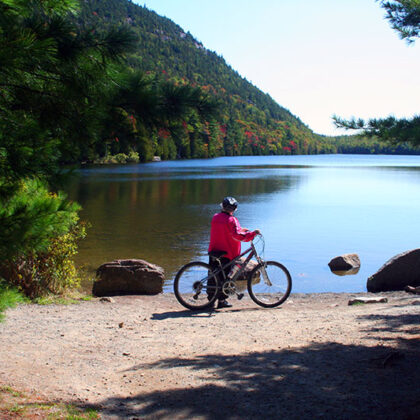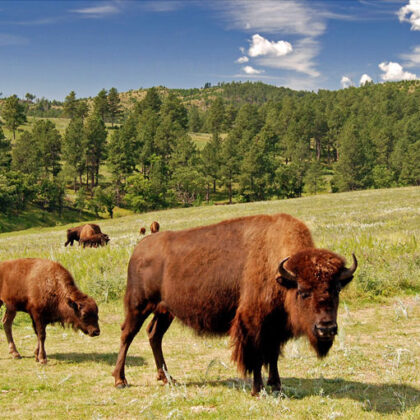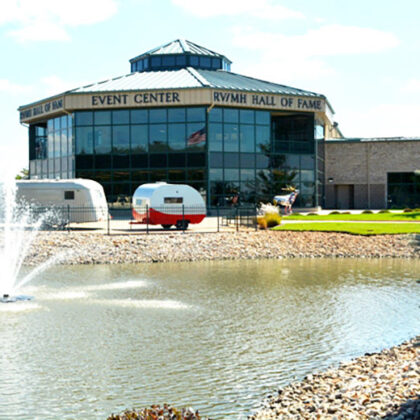What makes Strataca unique?
Strataca, dubbed one of the 8 Wonders of Kansas, is an underground salt museum that takes visitors 650 feet below the Earth’s surface. A 90-second ride down a dark shaft leads to a lithic abyss that showcases everything utilized and discovered during mining, along with a few extra surprises. There are fifteen mines of this kind in the United States, but Strataca is the only one that allows admission to the public.

Mining began in the early 1920s and continues today. The salt museum, itself, is a mere speck amongst the almost 1000 acres of excavation. Because the mine has been in operation for so many decades, mining techniques have evolved making production more efficient and seamless. These different mining methods are mentioned throughout the museum’s many exhibits and attractions. Most of the salt gathered and processed in this underground facility is used as road salt and mineral licks (salt licks).
The underground cavern is around 68 degrees Fahrenheit, so bring a jacket if that sounds chilly. The cool air coupled with the low humidity, salt absorbs moisture in the air and inhibits the growth of many types of bacteria and mold, makes for great storage.
Artifacts and documents have found homes in the nooks and crannies of the mine, including Hollywood films and costumes, old computer setups, complete newspaper clippings dated back to Abraham Lincoln’s assassination, and even trash left behind from miners in the 1920s.
What should visitors expect to see and do at Strataca?
After collecting our tickets, we were directed to wait for the next tour which took less than thirty minutes to begin. The expansive waiting area had several information boards regarding the mine and geological facts. A documentary about the underground salt mine was playing on a screen in the sitting area. We went on a weekday in February 2015 and the place was pretty desolate, the total number of visitors was under ten.
Orientation: Our tiny group was ushered into a side room that had rows of seats facing a flat screen. We watched a short clip about mine safety and features of the museum. The tour guide asked if we had any questions and then, once again, ushered us to an adjoining room that housed a number of safety hats for our choosing. All visitors venturing into the underground salt museum must wear one.

The Shaft: The Shaft is the gateway to the salt museum. It is a minute and a half long journey through layers upon layers of rock, approximately 1/10 of a mile below the earth’s surface. The Shaft can fit up to 30 people at a time. The ride itself is dark and will creak and moan on its descent. This may be a big reason why more do not flock to this site. Descending many feet in a metal box (clanging sounds included ) may not be a top item on bucket lists. However, safety seems to be at the forefront of this facility, and we did not feel in danger at any point on the tour.
That being said, I was a bit intimidated getting into the contraption, but the guide and other visitors kept a dialogue going with questions and comments about the Shaft and mining operations. At one point during the ride, the guide turned on her flashlight, allowing it to shine through the Shaft’s perforated window. We were awe struck observing the layers of sediment flash by as we zoomed down further.

Upon exiting the Shaft, visitors are able to take in the underground stretch of the salt mine. I, being the less brave of our duo, actually felt more comfortable in the openness. The space represented that of a giant hall or parking garage with shimmery walls. The air was clean, but (naturally) had hints of salt.
A side note: All of the underground exhibits and attractions flow into one another quite smoothly. We were broken up into groups once we reached the underground arena. Our group of four just happened to start in the gallery portions of the museum, but the other group began their tour with the train and tram rides. We always had the same tour guide, as well, on each venture. This could have been due to the fact that there were so few of us present. Regardless, there was always a guide or staff assistance available in every section of the museum.
The Permian Room: The Permian Room is the first gallery visitors will encounter. The wide, long corridor features exhibits, some interactive, regarding the Permian Period and the eventual formation of salt deposits underground, facts and uses of salt, and oddities found on the walls of the corridor formed naturally or man-made. Oddly enough, there are no fossils in the mine, a product of the evolutionary changes that it underwent.



Mining Galley: The Mining Gallery is another segment of the salt museum. Visitors are able to learn everything from working conditions to various equipment utilized throughout the many decades since the mine has been in operation. The actual hardware that was used to dig and blast through the acres of underground expanse are displayed with accompanying information boards and visual/audio demonstrations/documentaries.


A fun tidbit: The salt mines that link to the Strataca museum were featured in an episode of the once popular series, “Dirty Jobs” hosted by the infamous daredevil Mike Rowe. The entire episode is featured below.

Harry’s Habitat: This section of the self-guided tour is devoted to the most unlikely character. The oldest living organism was discovered within this geological wonder, a single salt dwelling bacteria named Harry. Harry is an estimated 250 million years old; try putting that many candles on a birthday cake! This little guy has undergone a number of studies in attempts to better understand the sustainability of life on this planet, and for that matter others.
 Meet Harry, the salt-dwelling bacteria.
Meet Harry, the salt-dwelling bacteria.Movie Memorabilia: As mentioned earlier, the conditions within the underground salt mine are ideal for eternally preserving items that would otherwise deteriorate overtime. The museum displays only a handful of this memorabilia. The rest is locked away in vaults throughout the underground matrix.



Salt Mine Express: Take a ride on the Salt Mine Express and experience corridors of the museum that are “literally” preserved in time. This 15-minute audio tour takes visitors through areas of the once active mine excavated during the 1940s and 1950s.
The Dark Ride: This tram takes visitors into the dark reaches of what was once an active mine, but light is included to actually show said environment. The tour, narrated by a tour guide, delves into the logistics of working in the mine, man-made and natural hazards, and how safety measures have been incorporated.




Other Attractions/Events Offered: One attraction we did not experience was the Safari Shuttle ride/hike. It is a more extensive tour that takes small groups further into inactive mine territory to view artifacts up close and hear many more underground tales.
Community involvement is quite evident when viewing the many year round events sponsored by Strataca. School field trips and overnight scout campouts are just a few activities offered to the youth. The public, at large, can sign up for the annual 5K race/walk in February or opt to attend a Murder Mystery Dinner Theater.
Amenities: There are a number of amenities offered above and below ground at Strataca for the comfort and convenience of visitors. Locker rooms allow visitors to store cumbersome packs, the bathrooms below are a site to see with the salt mine walls making up most of the room, a gift shop has a slew of geological merchandise, and if you get the munchies, snacks are sold in the museum. Not all attractions in the salt museum are handicap accessible, most notably the rides.
What are the hours of operation and admission prices?
Kansas Underground Salt Museum opens its doors to the public six days a week, excluding Mondays. Hours of operation are 9 AM to 5 PM, Tuesday through Saturday and 1 PM to 5 PM, Sundays. However, the final tours are taken below by 3 PM. Age limits are observed at Strataca; all visitors 4 years or older are welcome.
General admission underground ranges depending on age and range from $7.50 to $14.00. Discounts are offered to locals and active duty veterans. General admission encompasses all access to the salt museum save the rides. The price increases as rides are added. We paid a little under $20 per person for general admission plus train and tram tours. Not bad for such an in depth look into the underground world of salt mines!
Where is it located?

Kansas Underground Salt Museum is located on the southeast corner of Hutchinson, Kansas. If traveling on Interstate 135, exit onto the US-50, eastbound. Travel approximately 30 miles to the Yoder Road/Airport Road exit and head northbound. Strataca is located on the northwest corner of South Yoder Road and East Avenue G.
Strataca is a definite “must-see” if you are ever driving through middle Kansas. Check out this post when we completed the Annual 5K: Running in the Dark!
Thanks for reading the Gone Workamping blog from Workamper News. Join Workamper.com today to see all the new job opportunities for RVers, as well as the training and resources to confidently find the right Workamping job for you – easily and securely.







